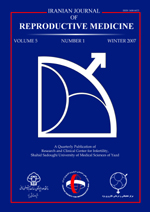
|
International Journal of Reproductive BioMedicine
Research and Clinical Center for Infertility, Shahid Sadoughi University of Medical Sciences of Yazd
ISSN: 1680-6433
EISSN: 1680-6433
Vol. 11, No. 7, 2013, pp. 551-558
|
 Bioline Code: rm13069
Bioline Code: rm13069
Full paper language: English
Document type: Research Article
Document available free of charge
|
|
|
International Journal of Reproductive BioMedicine, Vol. 11, No. 7, 2013, pp. 551-558
| en |
Propagation of human germ stem cells in long-term culture
Akhondi, Mohammad Mehdi; Mohazzab, Arash; Jeddi-Tehrani, Mahmood; Sadeghi, Mohammad Reza; Eidi, Akram; Khodadadi, Abbas & Piravar, Zeinab
Abstract
Background: Spermatogonial stem cells (SSCs), a subset of undifferentiated type A spermatogonia, are the foundation of complex process of spermatogenesis and could be propagated in vitro culture conditions for long time for germ cell transplantation and fertility preservation.
Objective: The aim of this study was in vitro propagation of human spermatogonial stem cells (SSCs) and improvement of presence of human Germ Stem Cells (hGSCs) were assessed by specific markers POU domain, class 5, transcription factor 1 (POU5F1), also known as Octamer-binding transcription factor 4 (Oct-4) and PLZF (Promyelocytic leukaemia zinc finger protein).
Materials and Methods: Human testicular cells were isolated by enzymatic digestion (Collagenase IV and Trypsin). Germ cells were cultured in Stem-Pro 34 media supplemented by growth factors such as glial cell line-derived neurotrophic factor, basic fibroblast growth factor, epidermal growth factor and leukemia inhibitory factor to support self-renewal divisions. Germline stem cell clusters were passaged and expanded every week. Immunofluorecent study was accomplished by Anti-Oct4 antibody through the culture. The spermatogonial stem cells genes expression, PLZF, was studied in testis tissue and germ stem cells entire the culture.
Results: hGSCs clusters from a brain dead patient developed in testicular cell culture and then cultured and propagated up to 6 weeks. During the culture Oct4 were a specific marker for identification of hGSCs in testis tissue. Expression of PLZF was applied on RNA level in germ stem cells.
Conclusion: hGSCs indicated by SSCs specific marker can be cultured and propagated for long-term in vitro conditions.
Keywords
Human germ stem cells; Human Spermatogonial stem cells; SFM; GDNF; LIF; OCT-4; PLZF
|
| |
© Iranian Journal of Reproductive Medicine
Alternative site location: http://www.ijrm.ir
|
|
